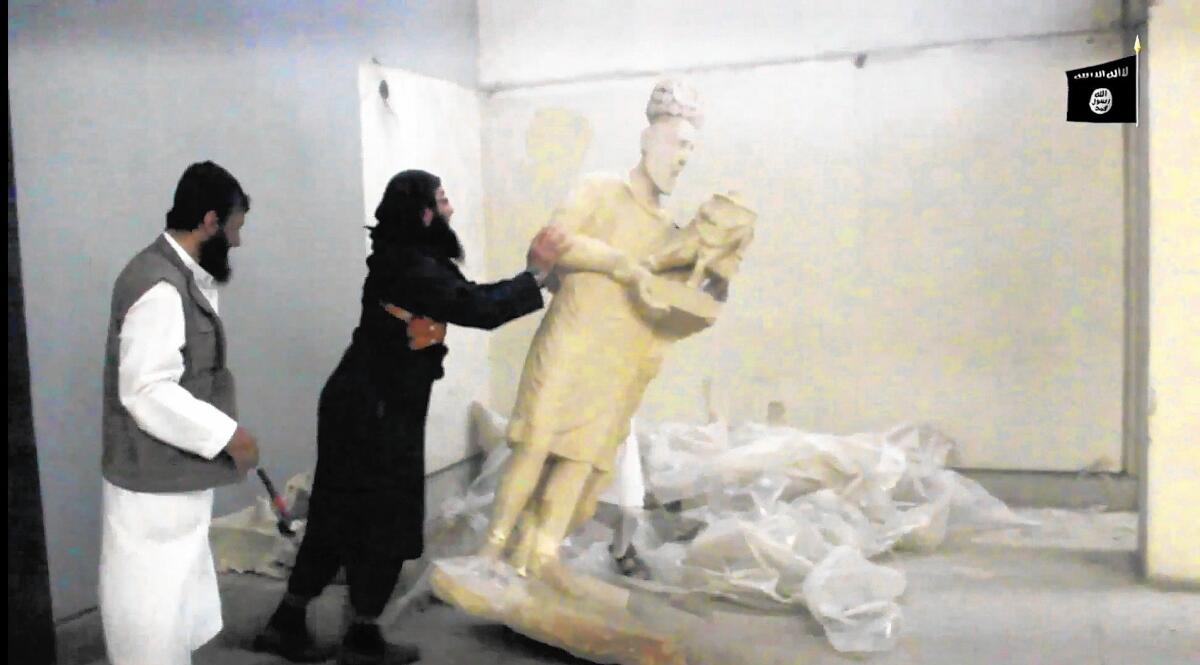Propaganda is here to stay. Is there a museum willing to tackle its complexity?

Last February, jihadists in Iraq released video of themselves gleefully smashing statues in the Mosul Museum near the capital city of the ancient Assyrian empire. The grotesque assault on art that the vandals claimed to be “idolatry” went viral, seen around the world by onlookers likewise horrified by earlier videos showing the beheading of human beings.
Social media deeply intersects with terrorism today, both as recruitment tool and information network. One result: Propaganda has taken unprecedented forms.
The names chosen at various times by Daesh (an Arabic acronym for Islamic State) — ISIS or ISIL — are grandiose disinformation, because the group is neither authentically Islamic nor a state. Middle East scholar Juan Cole has written that Daesh is to Islam what Kentucky snake handlers are to Christianity — “a tiny, weird cult.” But the faction has become darkly identified with its technological skill in crafting a uniquely vicious marketing message.
READ MORE: The 10 best art exhibitions at L.A. museums in 2015
Part of what is unique is that a traditional propaganda alliance would be with the cultural elite and powerful. But that doesn’t describe a “tiny, weird cult.” Daesh uses propaganda to depict itself as infinitely larger, more culturally formidable and more directly threatening than it really is.
Closer inspection of the Mosul video showed that the statue-smashing destroyed numerous authentic artifacts and some shoddy plaster copies. Much remains unknown about what was actually lost, but some of the flamboyant destruction may have been done as a cover for smuggling actual antiquities out of Iraq for black market sale.
As propaganda, though, the Mosul details hardly matter. Grandstanding is a propaganda norm.
Daesh doesn’t have much control beyond its immediate milieu. Its power resides in creating an amorphous environment of fear. Cold-blooded, rampaging ruthlessness was the primary Mosul video message, and it got delivered.
“Few people have the guts to say that art and propaganda are the same thing,” George Orwell famously wrote in 1936. He later tempered that caustic view, which was typical of his pugilistic style in standing up on behalf of the little guy. But there is truth to it. Certainly art and propaganda have a long history together in various trenches.
Propaganda was formally institutionalized in Rome in 1622 by Pope Gregory XV, thanks to the success of Baroque art. The pope established the Congregatio de Propaganda Fide — the Congregation for the Propagation of the Faith. The dramatic stories extravagantly told by Baroque painting, sculpture and — in abstract spatial terms — architecture had been instrumental in beating back image-shy Protestant attacks against Catholicism across Europe.
Gregory XV decided that a special group of cardinals might also recover losses abroad if given supreme control over all foreign missions. The propaganda effort went global.
When the Mosul Museum video was released in February, the Los Angeles County Museum of Art had just closed a fine, small-focus show centered on the loan of Eugène Delacroix’s celebrated 1826 masterpiece, “Greece on the Ruins of Missolonghi.” The large picture, now kept in a museum in Bordeaux, France, is based on momentous events in the Greek war of independence.
The painting’s art historical fame is largely the result of the stark stylistic shift in propagandistic subject matter embodied with such power. Delacroix brilliantly exploited stagy (if conventional) Baroque painting techniques to represent a largely secular political cause, rather than a religious ideal.
Propaganda moved its platform from church to state. But it got a bad name in the 20th century, thanks to the unspeakable evil of National Socialism in Germany. Not for nothing did Joseph Goebbels, Hitler’s right-hand henchman, mandate establishment of the Reichskulturkammer — the Reich Chamber of Culture, controlling all German art production. Goebbels’ bigger job was to head the Ministry of Public Enlightenment and Propaganda. Art was a ministry subset.
The gruesome fusion of German art and state propaganda steadily unfolded in the 1930s, its specter perhaps explaining why Orwell was so truculent in his 1936 claim that all art is propaganda. Knowing how to read its visual cues and stylistic techniques is certainly useful, perhaps now more than ever.
So is understanding its history over the last four centuries. What would be helpful now would be to see an art museum tackle the subject in a big, expansive way. Propaganda — like art — is here to stay.
christopher.knight@latimes.com
More to Read
The biggest entertainment stories
Get our big stories about Hollywood, film, television, music, arts, culture and more right in your inbox as soon as they publish.
You may occasionally receive promotional content from the Los Angeles Times.







